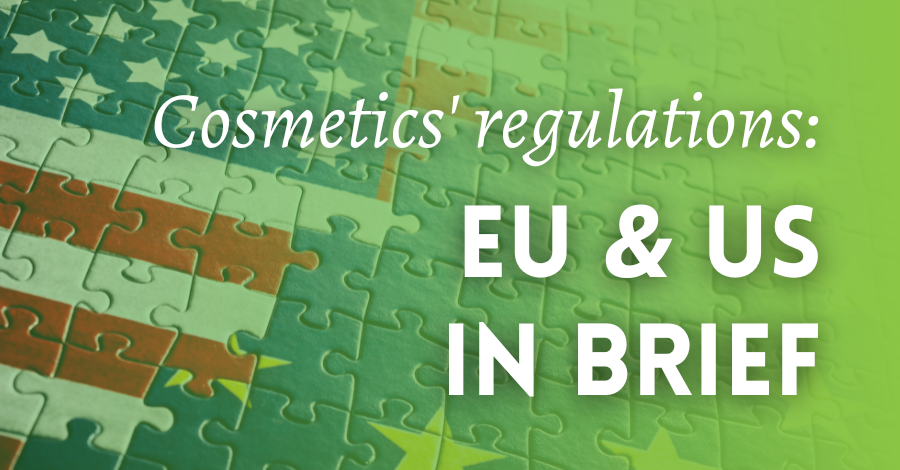Billed in the US as the most sweeping changes in cosmetics regulations in over a lifetime, the Modernization of Cosmetics Regulation Act (“MoCRA”) was signed into law by President Biden at the end of December, 2022. The new act brings in changes to the Food, Drug and Cosmetic Act (FDCA) that President Franklin D. Roosevelt signed in 1938.
The legislation, which has been over 10 years in the making, is significant as it sees the US adopt a more stringent approach to cosmetics’ safety that brings the States further on a par with European Union cosmetics’ regulation. In brief, the revised act gives the US Food and Drug Administration (FDA) greater powers to oversee the safety of cosmetics sold in the US, and the consumer greater transparency about the ingredients and manufacturer of their cosmetic products.
It places more obligations on cosmetics’ manufacturers and distributors based in or selling to the US to disclose information about cosmetic ingredients and adopt good manufacturing practices (GMP). It requires also more details on cosmetics’ labels. For example, fragrance in cosmetics is one area that comes under greater scrutiny thanks to MoCRA.
MoCRA has been welcomed by the personal care industry in the US as it finally updates the 1938 Act for the needs of a 21st-century industry. By doing so at federal level, it helps create a level playing field to promote fair trade among individual states, many of whom – most notably California – have introduced their own state legislation regulating aspects of the cosmetics’ industry.
If reading legislation is daunting, don’t worry, as we summarise below the key apects of MoCRA of interest to indie beauty businesses.
Indie beauty and MoCRA
Indie beauty and smaller-scale natural and organic cosmetics’ manufacturers may feel overwhelmed at the thought of compliance with MoCRA. However, it is likely that as an indie beauty firm, you are already providing transparency about your ingredients and supply chains as part of your brand ethos and marketing strategy. If you are an EU-based firm or selling into the EU, then your products will be undergoing safety assessments in order to be sold in the EU.
Some retailers specialising in green, clean, transparent and sustainable beauty brands have their requirements too. While these are not standardised, complying with, for example, requirements of the US’ largest clean beauty retailer Credo means you will be accustomed to rigorous vetting of your products against high benchmark standards. See our podcast episode with Credo’s VP of Sustainability for more on how they work with beauty brands.
The new legislation is binding on all manufacturers and distributors of cosmetics in the United States, irrespective of their size. However, MoCRA allows small businesses to have longer transition periods to comply with certain requirements in the Act, and has also given them waivers from some clauses.
If you are based outside the US, but selling to or distributing cosmetics in the US, MoCRA applies to you and you have a year to enact its requirements. We recommend that you do your own research to inform yourself thorougly on MoCRA to understand how it applies to your business.
EU and US cosmetics regulations: brief background
To put some perspective on the need for the US to update its legislation, we can take a look at the EU. It first issued a directive on cosmetics in 1976 which was updated in 2013 and is again under review. This latest consultation with industry on the directive is considering issues such as nanomaterials, including microplastics and endocrine disruptors in cosmetics. We covered concerns about microplastics and the EU’s legislative response in our podcasts:
Episode 115: The microplastics hiding in your cosmetics.
Episode 116: We must ditch plastics in cosmetics.
The EU Cosmetics Directive is considered as offering the world’s highest consumer protection against unsafe cosmetics and cosmetic ingredients. We often read about the FDA banning just nine ingredients in cosmetics with a further 11 prohibited by the Cosmetics Ingredient Review Panel (CIR) – an independent review body set up in the 1970s that is also responsible for the INCI list.
In comparison, the EU bans around 1,378 ingredients. However, this is not the whole story as around 80 per cent of the ingredients the EU bans would never be used in cosmetics. The US does though permit some ingredients on the EU’s banned list; the scientific research comes to different conclusions on some materials.
While both the US and EU jurisdictions have broadly similar aims – to protect consumers from unsafe cosmetics – their main point of difference lay, until MoCRA’s updates, in the obligations they imposed on manufacturers and distributors.
In the US, prior to this new legislation, the manufacturer need only make technical and safety information on their cosmetics available on a voluntary basis to the US Food & Drug Agency (FDA), the body responsible for overseeing the 1938 legislation. However, with MoCRA, this changes as the FDA will now require the accessibility of safety information and further disclosures from cosmetic manufacturers.
The Personal Care Council provides a concise comparison of EU and US cosmetics regulation.
MoCRA – the key points for indie beauty
Here, we summarise the main points that indie and small cosmetics’ manufacturing businesses need to note about the Modernization of Cosmetics Regulation Act. Do read further about MoCRA as we cannot spell out all the details here, nor give advice specific to your business operating in or selling to the US.
If you are familiar with EU cosmetics’ regulations, several aspects of MoCRA are now similar; such as the need for a “responsible person” (usually the manufacturer) to be named and to ensure the compliance of each cosmetic product manufactured.
1. Registration with the FDA
A new requirement is made for cosmetics’ manufacturers operating in the US market, whether based in the US or overseas, to register with the FDA. In addition, the responsible person must register each cosmetic made, including its ingredients and place of manufacture, with the FDA. There are time windows for registration depending on whether the cosmetic appeared on the market before or after MoCRA became law, and once listed, cosmetic product details must be updated annually.
2. Adverse reaction record keeping
The manufacturer (“responsible person”) must report any serious adverse reactions and new medical information associated with use of its products to the FDA no less than 15 days after becoming aware of the information or incident. The law now requires businesses to keep records on adverse reactions for six years, or three years if they are small businesses. This brings the FDA’s requirements in line with similar obligations it imposes on over-the-counter drugs and dietary supplement manufacturers. The definition of what constitutes an adverse reaction is also extended.
3. Evidence of a cosmetic’s safety
This is one of the most important changes to be aware of. The FDA now requires “adequate substantiation” of a cosmetic product’s safety and sets standards for this. Again, the responsible person must provide this evidence and maintain records of product safety. No longer is this voluntary to do. This change is the one that most brings the US regulations in line with EU cosmetic legislation which requires the responsible person to have product safety assessments performed and to be uploaded to the EU’s cosmetic product notification portal (CPNP).
4. Cosmetic product labeling / fragrance allergen disclosure
The FDA has very specific labeling requirements for cosmetics’ products on the US market. MoCRA now extends this to require labels to detail each fragrance allergen in a cosmetic. The FDA has yet to issue the allergen list at the time of writing. It is likely to mirror the EU fragrance allergen list, which itself is under review and may be extended beyond the current 26 identified to include some 80 potential allergens.
5. GMP requirements
The FDA will be drawing up requirements for manufacturers to demonstrate compliance with good manufacturing practices in line with national US and international guidelines.
6. Product recalls
The FDA will now have the authority to issue mandatory product recalls of cosmetics deemed unsafe on the market. Previously, although the FDA had monitoring and oversight responsibilities and firms had obligations, the body could only request a firm to recall a product. There have been some high profile product recalls in recent years with Johnson & Johnson Baby Powder (talc) the most notable. We covered another example – the Liz Earle product recall due to the failure of the synthetic preservative system which included phenoxyethanol.
Further reading and references
We advise you to keep a close eye on the FDA cosmetics website for news of implementation of these and other aspects of MoCRA, in particular the need to register yourself as the responsible person of a manufacturer or distributor of cosmetics in the US.
FDA Cosmetics – official site for cosmetics’ news, registration, compliance and more.
Congress modernises FDA’s cosmetics authorities (briefing paper: US legal practice Covington).
Cosmetic industries’ body welcome US’ modernization of cosmetics regulation act – Cosmetics Business News.
Consolidated Appropriations Act, 2023 – see chapter VI on FDA authorities (United State Senate Committee on Appropriations).
Leave us a comment

Liz was Formula Botanica’s Content Coordinator between August 2020-2024. Liz worked as a professional blogger, journalist and site developer for many years and was also part of the Formula Botanica student community. Read more about the Formula Botanica Team.

























